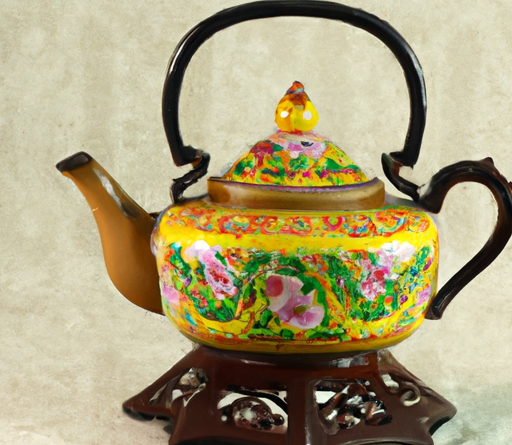Experience the rich and vibrant flavors of Thailand as you embark on a culinary journey like no other. Dive into a world of delectable dishes that will tantalize your taste buds and leave you craving for more. From the fiery spice of Tom Yum soup to the fragrant aromas of Pad Thai, Thailand’s cuisine is a treasure trove waiting to be discovered. Join us as we unlock the secrets of this culinary paradise and uncover the authentic flavors that have made Thai cuisine renowned around the world. Get ready to indulge in a feast for the senses as you explore the savory delights that Thailand has to offer. Thailand is a country known for its vibrant culture, stunning landscapes, and warm hospitality. But perhaps one of its greatest treasures lies in its culinary traditions. Thai cuisine is renowned worldwide for its bold flavors, vibrant colors, and exquisite balance of sweet, sour, salty, and spicy. In this article, we will take you on a journey through Thailand’s authentic culinary treasures, from exploring traditional ingredients to uncovering regional varieties, delving into street food delights, and even mastering the art of Thai cooking.
Exploring Traditional Thai Ingredients
At the heart of Thai cuisine are a variety of herbs and spices that give each dish its distinct flavor profile. Key ingredients such as lemongrass, galangal, kaffir lime leaves, and Thai basil are commonly used in Thai cooking, adding aromatic and refreshing notes to dishes. These herbs and spices not only contribute to the unique taste of Thai cuisine but also offer various health benefits.
Another staple ingredient in Thai cuisine is rice. Thailand is one of the largest exporters of rice in the world, and rice is an essential component of nearly every Thai meal. Whether it’s steamed jasmine rice or sticky rice, this versatile grain serves as the foundation for many delicious dishes.
Coconut milk is another ingredient that plays a crucial role in Thai cooking. It adds richness and creaminess to curries, soups, and desserts, and its unique flavor pairs well with the bold and spicy flavors of Thai cuisine.
Fish sauce is often referred to as the secret ingredient in Thai cuisine. Made from fermented fish, fish sauce is used as a seasoning in countless Thai dishes, providing depth of flavor and umami notes. It may sound unusual to some, but it is a staple condiment in Thai cooking.
Last but not least, Thai chili paste, also known as Nam Prik Pao, is a flavorful blend of roasted chili, garlic, and shrimp paste. It is a staple in Thai households and is used to add heat and depth to many Thai dishes, including stir-fries, soups, and dipping sauces.
Uncovering Regional Culinary Varieties
Beyond its traditional ingredients, Thai cuisine also boasts a wide range of regional culinary varieties. Each region of Thailand has its own unique style of cooking, influenced by the local culture, geography, and available ingredients.
Northern Thai cuisine, also known as Lanna cuisine, is characterized by its mild flavors and the use of fresh herbs and vegetables. Popular dishes include Khao Soi, a coconut-based curry noodle soup, and Sai Oua, a flavorful Northern Thai sausage.
Isaan cuisine, from the northeast region of Thailand, is known for its bold and spicy flavors. Sticky rice, grilled meats, and som tam (papaya salad) are signature dishes in Isaan cuisine, showcasing the region’s love for fiery flavors.
Central Thai cuisine, which includes the cuisine of Bangkok, is perhaps the most well-known and widely available in Thailand. It is characterized by its intricate flavors, balanced seasoning, and the use of fresh herbs and spices. Pad Thai, Tom Yum Goong, and Green Curry are just a few examples of popular Central Thai dishes.
Southern Thai cuisine is famous for its spicy and pungent flavors, influenced by the nearby Malay and Indonesian cuisines. Rich curries, fiery salads, and fresh seafood dishes are staples in Southern Thai cuisine.
In addition to these regional varieties, Thailand is also home to various indigenous tribes, each with their own traditional culinary practices. Traditional tribal foods offer a glimpse into the rich cultural heritage of Thailand and often feature unique ingredients such as wild mushrooms, bamboo shoots, and herbal plants.
Discovering Street Food Delights
No culinary journey through Thailand would be complete without indulging in the vibrant world of Thai street food. Thailand is renowned for its bustling street food markets, where you can find an endless array of delicious and affordable dishes.
From the savory and aromatic flavors of Pad Thai to the tangy and spicy goodness of Tom Yum Goong, Thai street food offers a diverse range of flavors and textures. Other popular street food dishes include green papaya salad (Som Tam), grilled meat skewers (Moo Ping), and crispy spring rolls (Poh Pia Tod).
Exploring the street food markets and interacting with the local vendors is an experience like no other. You can witness the skill and expertise of the vendors as they whip up delectable dishes right before your eyes. The sights, sounds, and smells of the bustling markets create a sensory overload that is sure to leave a lasting impression.
Delving into Thai Royal Cuisine
Thai royal cuisine, also known as palace cuisine, is a refined and elegant style of cooking that originated from the royal palaces of Thailand. It is characterized by its meticulous preparation, artistic presentation, and the use of premium ingredients.
Influenced by the culinary traditions of the ancient Siamese courts, Thai royal cuisine showcases the sophistication and grace of Thai culture. Delicate flavors, intricate decorations, and impeccable attention to detail are hallmarks of this culinary tradition.
Traditional royal Thai dishes often feature a harmonious combination of flavors, textures, and colors. Each dish is meticulously crafted to be visually appealing and to showcase the finest ingredients available. Some popular examples of Thai royal dishes include Gaeng Som Cha Om Kai (spicy and sour curry with acacia omelette), Yam Mamuang (green mango salad), and Goong Chae Nam Pla (raw shrimp with fish sauce).
Embarking on a Seafood Adventure
With its long coastline and abundant waterways, Thailand offers a seafood paradise for both locals and visitors. Coastal Thai cuisine is characterized by its fresh and flavorful seafood dishes, including grilled fish, steamed fish, and spicy seafood curries.
Alongside coastal cuisine, Thailand’s freshwater delicacies are equally enticing. From succulent river prawns to plump catfish, freshwater fish takes center stage in many Thai dishes. Grilled or steamed, these freshwater delicacies are often enjoyed with a spicy dipping sauce to enhance their natural flavors.
One of the most famous seafood dishes in Thailand is Pla Pao, or grilled fish. Whole fish, typically stuffed with lemongrass, kaffir lime leaves, and garlic, is grilled to perfection and served with a spicy seafood sauce. The smoky flavors from the grill and the aromatic herbs make this dish an absolute must-try for seafood lovers.
If you’re feeling adventurous, Thailand also offers exotic seafood specialties that are sure to leave a lasting impression. From deliciously crunchy fried insects to creamy and tangy sea urchin roe, these unusual delicacies are a testament to the diverse culinary landscape of Thailand.
Unleashing the Magic of Thai Curries
Thai curries are perhaps the most iconic dishes in Thai cuisine, known for their bold flavors and vibrant colors. Each curry has its own unique combination of herbs, spices, vegetables, and proteins, resulting in a delicious symphony of flavors that Thai cuisine is so famous for.
Green Curry, Red Curry, and Yellow Curry are among the most popular and widely enjoyed Thai curries. Green Curry is known for its spicy and aromatic flavors, while Red Curry offers a slightly sweeter taste. Yellow Curry, on the other hand, is milder and often favored for its creamy texture.
One curry that stands out from the rest is Massaman Curry. Often referred to as a fusion curry, Massaman Curry showcases the influence of Indian and Middle Eastern cuisines on Thai cuisine. This rich and fragrant curry is made with a blend of spices such as cinnamon, cardamom, and nutmeg, resulting in a uniquely flavorful dish.
Panang Curry is another famous Thai curry, known for its creamy and rich texture. It is made with a thick coconut milk base, combined with aromatic herbs and spices, creating a velvety sauce that coats the ingredients perfectly.
Aside from the well-known curries, Thailand is also home to a variety of lesser-known curries that are equally delicious. From the spicy and tangy jungle curry to the aromatic and refreshing green peppercorn curry, these lesser-known curries offer a delightful exploration of Thai flavors.
Indulging in Sweet Thai Treats
No meal is complete without a sweet ending, and Thai cuisine offers a delightful array of sweet treats to satisfy your cravings. Thai desserts are known for their intricate designs, unique flavors, and a beautiful balance of sweet and tangy.
One of the most iconic Thai desserts is Sticky Rice with Mango. This simple yet irresistible dessert features sticky rice cooked in coconut milk, served with ripe mango slices and a drizzle of sweet coconut syrup. The combination of creamy, sweet, and slightly salty flavors creates a heavenly dessert that is loved by locals and tourists alike.
Coconut plays a significant role in Thai sweets as well. Coconut-based sweet delicacies such as Coconut Ice Cream, Coconut Custard, and Coconut Pancakes are popular choices among dessert enthusiasts. The creamy and fragrant flavor of coconut pairs perfectly with the sweetness of these desserts and creates a delightful treat for your taste buds.
Thai Jelly and Custard is another dessert that showcases the artistry and creativity of Thai cuisine. These colorful and translucent jellies, often served with a rich custard sauce, are a feast for the eyes and palate.
For the adventurous food lover, Thai Durian is a unique treat that shouldn’t be missed. Known as the “king of fruits,” Durian has a strong, pungent aroma that is either loved or loathed. Its custard-like flesh is sweet and creamy, making it a beloved ingredient in many Thai desserts.
Mastering the Art of Thai Cooking
If you’re truly passionate about Thai cuisine, why not take your culinary journey one step further and learn the art of Thai cooking? Attending a Thai cooking class is an excellent way to immerse yourself in the flavors, techniques, and traditions of this incredible cuisine.
Thai cooking techniques are as diverse as the ingredients themselves. From stir-frying and steaming to grilling and boiling, each technique adds its own unique touch to the final dish. Discovering these techniques and mastering them will allow you to recreate the bold and authentic flavors of Thai cuisine in your own kitchen.
Having the right cooking equipment is also crucial in Thai cooking. From a traditional mortar and pestle for grinding herbs and spices to a wok for stir-frying, investing in the right tools will make your Thai cooking experience more authentic and enjoyable.
Balancing flavors is another essential aspect of Thai cooking. Thai cuisine is known for its harmonious blend of sweet, sour, salty, and spicy flavors, creating a complex taste profile. Learning how to balance these flavors with the right amount of herbs, spices, and seasonings will elevate your cooking skills to the next level.
Thai cuisine offers a wide variety of popular dishes that you can easily recreate at home. Recipes for classic dishes such as Pad Thai, Tom Yum Goong, and Green Curry are widely available and provide a great starting point for your Thai cooking adventures.
And if you’re truly dedicated to honing your Thai cooking skills, attending a Thai cooking class is an experience like no other. Under the guidance of experienced Thai chefs, you can learn the intricacies of Thai cuisine, explore new flavors and techniques, and discover the secrets behind some of your favorite dishes.
Finding Culinary Inspiration in Thai Markets
To truly understand the essence of Thai cuisine, one must explore the local markets that are the lifeblood of Thai food culture. Thai markets are bustling hubs of activity, offering a vibrant mix of fresh produce, aromatic herbs, and traditional ingredients.
Visiting a Thai market is a feast for the senses. The vibrant colors of fresh fruits and vegetables, the fragrant smells of herbs and spices, and the energetic atmosphere create an experience that is both exciting and inspiring. It is in these markets that you can witness the incredible diversity of Thai ingredients and discover new and exotic flavors.
Thai markets are also a great place to interact with the local community and learn about their culinary traditions. From street food vendors to local farmers, you can gain valuable insights into the regional variations and cultural influences that shape Thai cuisine.
Exploring Thai markets is not only a visual and olfactory delight, but it also offers a unique opportunity to taste and sample a variety of local delicacies. Whether it’s freshly squeezed fruit juices, grilled meats on skewers, or aromatic curries, the market vendors take pride in their craft and offer a mouthwatering selection of dishes.
Take your time to wander through the market, ask questions, and try new flavors. You never know what culinary treasures you might discover or what new inspirations you might bring back to your own kitchen.
Exploring the Influence of Buddhism on Thai Cuisine
Thailand is a predominantly Buddhist country, and the influence of Buddhism can be seen in many aspects of Thai life, including its cuisine. Buddhist principles have shaped Thai food culture, influencing not only the ingredients but also the rituals and traditions associated with food.
One of the key principles of Buddhism is compassion towards all living beings, which has led to the popularity of vegetarian and vegan Thai dishes. Many Buddhist temples in Thailand offer vegetarian meals to their visitors, known as “Jay” food. These dishes are made without meat or animal products and are often packed with flavor and creativity.
Monastic influence on Thai cooking is another important aspect to consider. Thai monks follow strict food rules and rely on alms for their meals. This practice has influenced the development of specific monastic dishes that are simple, nutritious, and made from readily available ingredients. These dishes offer a glimpse into the spiritual aspect of Thai cuisine and the role it plays in the daily lives of Thai monks.
The ritual of offering food to monks, known as “Tak Bat,” is an integral part of Thai Buddhist culture. Devotees gather at temples early in the morning to offer food to the monks, who in turn provide blessings and teachings. This ritual not only serves as a way of providing sustenance to the monastic community but also fosters a sense of community and generosity among the Thai people.
Mindful eating is also emphasized in Thai Buddhist culture. Monks are taught to eat mindfully, savoring each bite and being fully present in the moment. This practice of mindful eating is something that can be embraced by anyone, allowing us to appreciate the flavors, textures, and aromas of our food and cultivate a deeper connection with the nourishment it provides.
Unlocking Thailand’s Authentic Culinary Treasures
Thailand’s culinary treasures are as diverse and complex as the country itself. From traditional ingredients and regional varieties to street food delights and royal cuisine, Thai food offers a journey of exploration for your taste buds.
By unlocking the secrets of Thai cooking, you can recreate the bold flavors, vibrant colors, and exquisite balance of Thai cuisine in your own kitchen. Immerse yourself in the world of Thai ingredients, master the art of balancing flavors, and find inspiration in Thai markets.
As you embark on this culinary adventure, remember to approach each dish with curiosity, openness, and a willingness to learn. Thai cuisine is a reflection of a rich and vibrant culture, and by unlocking its culinary treasures, you are not only satisfying your taste buds but also connecting with the heart and soul of Thailand. So, grab your apron, sharpen your knives, and get ready to embark on a culinary journey that will transport you to the sunny and flavorful land of Thailand.






